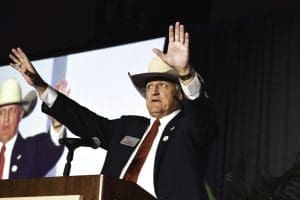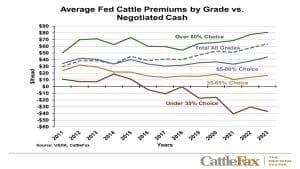By Larry Stalcup Contributing Editor

Todd Wilkinson hasn’t minced many words in his term as this year’s National Cattlemen’s Beef Association (NCBA) president. Thus, it wasn’t surprising to hear him jump in the face of R-CALF and other cattle-oriented groups that are anti-Beef Checkoff. The South Dakota rancher was among the speakers at this fall’s annual Texas Cattle Feeders Association (TCFA) convention in Grapevine. Along with Wilkinson, CattleFax CEO Randy Blach and a Texas Beef Council panel also highlighted the convention. They discussed how the checkoff has helped fund research and promotion that helps increase consumer demand for high-quality beef that’s paying off through premiums when cattle are marketed.
“I have never been known to be politically correct,” said Wilkinson, who headed various NCBA committees on cattle traceability and other issues before taking the reins as NCBA president last February. “As I stood on the stage in New Orleans [at the Cattle Industry Convention], I felt like it was time to put on the boxing gloves and hit some punches for this industry.”
The mention of animal rights activists puts a big burr under his saddle. These activists have long had goals of eliminating animal agriculture, he said, and those efforts are growing. “Never before have I seen as many animal rights activist groups,” he said. “They have a combined $600 million budget, and they’re coming after you and putting their money toward Farm Bill proposals. One of the biggest ways is going after the checkoff.”
These groups include the usual suspects: the Humane Society of the United States (HSUS) and the American Society for the Prevention of Cruelty to Animals (ASPCA). “We have a group in the U.S. that professes to be producers that has joined forces with them,” Wilkinson said. “How R-CALF can get in bed with HSUS and ASPCA and then tell me they know what’s better than this organization is bunk.”
Beef for Babies
The rewards from research funded by the Beef Checkoff have opened new avenues for getting beef into more diets. Molly McAdams, Ph.D., and executive vice president of the Texas Beef Council (TBC), moderated a panel on the value of beef in a healthy diet. Discussion ranged from how family physicians need more training in nutrition, to how beef protein can benefit consumers from infants to the elderly.
One panel member was Keli Hawthorne, director of clinical research and culinary medicine for the University of Texas (UT) Dell Medical School Department of Pediatrics in Austin. She addressed the need for introducing beef to infants.
“We need to get beef into an infant’s diet at the age of 6 months when they begin eating solid food,” she said, noting that research shows the value of beef in providing nutrients needed to help infants develop better growth patterns.
UT’s culinary medicine program helps educate medical students on all phases of food nutrition and even preparation. “We want to teach students about nutrition issues,” Hawthorne said. “We also want to teach students about cooking skills.”
The lack of physician training in nutrition was amplified by Charlie Risinger, MD, who practices family medicine through Baylor Scott & White Family Medical Center. He has duel interests in educating physicians on beef, as he has long been active in cattle feeding and production in central Texas and the Panhandle.
“Medical education is extremely poor in nutrition training for physicians. They have a tremendous anti-red meat bias,” he said. “That’s what many were taught. But we have research that supports the use of red meat in healthy diets.”
Risinger added that Beef Checkoff dollars can go a long way in helping change their attitude toward beef. “Evidence has changed. Studies are out there that document the safety of having beef in a nutrition program,” he explained. “It’s a tough audience to get into and to change opinion. You have to have the science [to change their minds]. They have to understand we have a product that is good for their patients.”
Staci Musgrove, regional manager for TBC’s Medical Office Outreach Program, said her reps are helping use checkoff dollars to sway physicians. “We talk to family physicians about the truth about beef,” said Musgrove. “We have reps across Texas who talk to family physicians every day on how and why they can recommend beef as part of a healthy diet. We provide scientific evidence that beef is good in a heart-healthy diet.”
Part of that research shows how beef is just as nutritious as poultry or other lean meats in a healthy diet. Musgrove’s team goes as far as asking physicians, “If you’re not telling your patients to limit chicken in your diet, why are you telling them to limit beef? These [checkoff-funded studies] give us a leg to stand on. We can present research to change minds.”
New TCFA Officers
Outgoing TCFA Chairman Michael Bezner said the association’s staff, board of directors and executive committee remain on top of numerous state and national issues that impact feeders and producers. Further addressing anti-checkoff legislation, Bezner said TCFA helped NCBA and other cattle groups garner opposition to the Opportunity for Fairness in Farming (OFF) Act, which would restrict the use of checkoff funds in helping promote beef marketing and research.
As Bezner finished his term, Gene Lowery of Dalhart, Texas, was elected the new chairman. Robby Kirkland of Vega was named chairman-elect, while Laphe LaRoe of Amarillo was elected as vice chairman.
CATTLEFAX UPDATE
High Prices Expected to Continue in 2024
With tight cattle supplies and continued pressure from drought, profits to cow-calf operations are projected to hit $500 per head in 2024. And it’s about time, cheered Randy Blach, CattleFax CEO.
Blach updated feeders and producers on what to expect in 2024 during his presentation at the TCFA Convention. “It’s been nearly seven years since there were sound profits in the cow-calf sector,” he said. “It’s good for the industry when we are all in the black.”
Expect markets to remain high for calves, feeders and fed cattle due to even fewer cattle numbers and dry conditions in the Southern Plains, he added. “South Texas is still critically dry,” he said. “We need more green grass in the Southern Plains.”

Slow Herd Expansion Continues
Blach said CattleFax data shows it may be 2026 before herd expansion puts beef cow numbers above 29 million head. The data shows numbers dipped from 30 million head to below 29 million in 2023. Further herd reduction sees both 2024 and ‘25 at about 28.6 million, with growth slowly picking up in 2026 to 29.2 million head, according to USDA and CattleFax data. Look for more feedyards to finish beef-on-dairy cattle in the next few years, Blach said. Texas dairy cow numbers have doubled since 2005 and will be at about 650,000 at the beginning of 2024.
“I think this is a long-term change in our industry,” Blach continued. “We’re looking at the potential of 4 million of these animals to move through our production systems on an annual basis. [Beef-on-dairy feeding numbers] are back to 9 percent and could go to 14 to 15 percent. They could be 20 percent, depending on what kind of expansion rate we see.”
A surplus of harvest capacity continues to grow, again due to fewer cattle. Carcass weights have gone up by 5 to 6 pounds per year for 20 years, but have leveled off to 870 to 880 pounds, Blach said. However, weight may increase more into 2025 and 2026. “As long as we’re driven by weight, we will continue to put on more pounds,” he said.
Powerful Premiums for Quality
Overall, fed cattle have never graded higher, thanks to better genetics, and production and feeding practices. Premiums can be mega. Higher quality cattle can bring more than $80 per head over cattle sold through negotiated cash trade, Blach said.
For 2023, cattle grading more than 80 percent Choice brought $80 more per head than cattle sold by normal negotiated trade, according to USDA and CattleFax data. Cattle that graded 65 to 80 percent Choice showed a premium of more than $40 per head. Those 35 to 65 percent Choice had a more-than $15 per head premium. Those below 35 percent Choice were discounted by more than $35 per head.
The best news is that USDA and CattleFax data show cattle are grading higher overall. Texas fed cattle are pushing 70 percent Choice, while Kansas and Nebraska are near 85 percent Choice. The data indicated that a combination of all fed cattle grades showed a premium of more than $60 per head.







